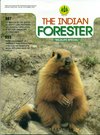Rapid Assessment of Proposed Reintroduction Sites for the Manipur's Brow-antlered Deer or Sangai
DOI:
https://doi.org/10.36808/if/2018/v144i10/139565Keywords:
Reintroduction, Manipur's Brow Antlered Deer, Floating Meadows, Sangai, Second HomeAbstract
Manipur's brow-antlered deer or sangai, is one of the most threatened species of deer found as a single, small and isolated population the Keibul Lamjao National Park (KLNP), Manipur. The major factors affecting its survival are its poor genetic status, deteriorating habitat conditions, lack of connectivity with the surrounding landscapes and mortality due to poaching and diseases. For its continuous existence in the wild, the best strategy is to create a second population at a suitable site that guarantees its long-term survival. Five sites with ecosystem components similar to those of KLNP, comprising wetlands (locally called Pat) and forest areas were surveyed. A qualitative ecological and disturbance scoring matrix was used to assess these sites. Pumlen Pat with adjoining Thongam Mondum Reserve Forest was identified as the best site for reintroduction of Sangai, which can be managed as a conservation reserve for the sustainable development of the area.References
Envis Centre Manipur. (2008). State of Environment Reports and its issues with database management. Government of Manipur, Directorate of Environment.
Hussain S.A. and Badola R. (2013). Conservation ecology of Sangai (Rucervus eldii eldii) and its wetland habitat, Manipur. A study report. Wildlife Institute of India. 1: 321.
Hussain S.A, Singsit S., Angom S., Kipgen K. and Vaiphei N. (2006). The brow-antlered deer of Manipur Cervus eldii eldii, McClelland 1842: A review of its status, ecology and conservation. Indian Forester, 132(12): 40-50.
Ranjitsinh M.K. (1975). Keibul Lamjao Sanctuary and the browantlered deer- 1972 with notes on a visit in 1975. J. Bombay Natural History Society, 72 (2): 243-255.
Seddon P.J., Armstrong D.P. and Maloney R.F. (2007). Developing the science of reintroduction biology. Conservation Biology, 21(2): 303-312.
Singh K.J. (2011). Langol Hill Range, the carbon sink of Imphal City. Kangla online. http://kanglaonline.com/2011/10/langol-hillrangethe-carbon-sink-of-imphal-city/
Sutton A.E. (2015). Leadership and management influences the outcome of wildlife reintroduction programs: findings from the Sea Eagle Recovery Project. PeerJ 3:e1012; DOI 10.7717/peerj.1012
Tuboi C. (2013). Assessment of water quality and biomass productivity of the tropical floating meadows of Keibul Lamjao National Park, Manipur. Ph.D.thesis. Saurashtra University, Rajkot, Gujarat, India.
Tuboi C., Angom S., Babu M.M., Badola R. and Hussain S.A. (2012). Plant species composition of the floating meadows of Keibul Lamjao National Park, Manipur. NeBio, 3: 1–11.
Tuboi C. and Hussain S.A. (2016). Factors affecting forage selection by the endangered Eld's deer and hog deer in the floating meadows of Barak-Chindwin Basin of North-east India. Mammalian Biology, 81: 53–60.
WII. (2018). Action plan for conservation breeding of Sangai. Wildlife Institute of India. 20 pp.
Downloads
Downloads
Published
How to Cite
Issue
Section
License
Unless otherwise stated, copyright or similar rights in all materials presented on the site, including graphical images, are owned by Indian Forester.





